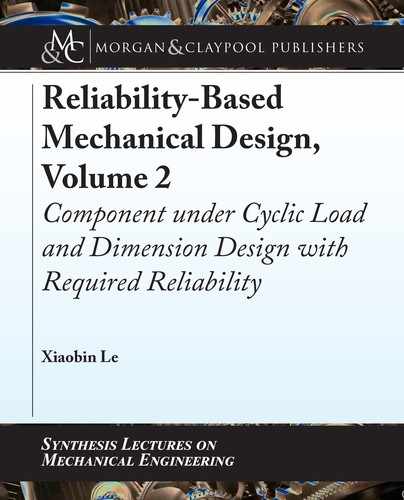
152 3. THE DIMENSION OF A COMPONENT WITH REQUIRED RELIABILITY
3.3 DIMENSION OF A COMPONENT WITH REQUIRED
RELIABILITY UNDER STATIC LOADING
3.3.1 INTRODUCTION
e limit state functions of a component under different static loading conditions for strength
issue and deformation issue have been discussed in Chapter 4 of Volume 1 [1]. After the limit
state function of a component under specified static loading is established, the FOSM, modified
H-L, modified R-F, and/or the modified Monte Carlo method discussed in Section 3.2 can be
used to conduct component dimension design, that is, to determine the dimension with the
required reliability.
In this section, we will demonstrate examples to show how to run dimension design with
the required reliability under axial loading, direct shearing, torsion, bending moment, and com-
bined loadings.
3.3.2 COMPONENT UNDER STATIC AXIAL LOADING
e limit state function of a component and its reliability calculation under axial loading for
strength issue and deformation issue have been discussed in detail in Section 4.6 of Volume
1 [1]. After the limit state function of a component under static axial loading is established, we
can run the dimension design with the required reliability. Now we will use examples to show
how to conduct component dimension design.
Example 3.9
A rectangular plate is subjected to axial loading. Per design specification, the axial loading
follows a normal distribution with a mean
F
D 25:12 (klb) and a standard deviation
F
D
3:29 (klb). e material is ductile, and its yield strength follows a normal distribution with
a mean
S
y
D 34:5 (ksi) and a standard deviation
S
y
D 3:12 (ksi). e Young’s modulus of
this material follows a normal distribution with a mean
E
D 2:76 10
4
(ksi) and a standard
deviation
E
D 6:89 10
2
(ksi). e plate has a thickness t D 0:375 ˙ 0:005
00
and a length
L D 15:250 ˙ 0:010
00
. Per design specification, the required reliability of this plate is 0.99, and
the allowable axial deformation is 0.015
00
. Use the modified H-L method to determine the
height d of the plate with a dimension tolerance ˙0:005
00
.
Solution:
In this example, there is no dimension-dependent parameter.
(1) e limit state functions.
e deformation of the plate due to the axial loading F is
ı
D
FL
EA
D
FL
Etd
:
(a)

3.3. DIMENSION OF A COMPONENT UNDER STATIC LOADING 153
e limit state function of the plate for the deformation issue is
g
1
.
E; F; L; t; d
/
D 0:015
FL
Etd
D
8
ˆ
ˆ
<
ˆ
ˆ
:
> 0 Safe
0 Limit state
< 0 Failure:
(b)
e normal stress of the plate due to the axial loading F is
D
F
A
D
F
td
: (c)
e limit state function of the plate for the strength issues is
g
2
S
y
; F; t; d
D S
y
F
td
D
8
ˆ
ˆ
<
ˆ
ˆ
:
> 0 safe
0 Limit state
< 0 Failure:
(d)
In these two limit state functions (b) and (d), there are six normally distributed random vari-
ables. e mean and the standard deviation of length L and thickness t can be determined per
Equation (1.1). e standard deviation of normally distributed d can be determined per Equa-
tion (1.1). eir distribution parameters in the two limit state functions (b) and (d) are listed in
Table 3.20.
Table 3.20: Distribution parameters for the limit state functions (b) and (d)
E (ksi) F (klb) L (in)
μ
E
σ
E
μ
F
σ
F
μ
L
σ
L
2.76×10
4
6.89×10
2
25.12 3.29 15.25 0.0025
t (ksi) S
y
(klb) d (in)
μ
t
σ
t
μ
S
y
μ
S
y
μ
d
σ
d
0.375 0.00125 34.5 3.12
μ
d
0.00125
(2) Use the modified H-L method to determine the mean
d
of the height d of the plate.
We can follow the procedure of the modified H-L method discussed in Section 3.2.3
and the flowchart shown in Figure 3.2 to compile a MATLAB program for the limit state
function (b) for the deformation issue, and another MATLAB program for the limit state func-
tion (d) for the strength issue.
e iterative results for the deformation issue are listed in Table 3.21.
..................Content has been hidden....................
You can't read the all page of ebook, please click here login for view all page.
